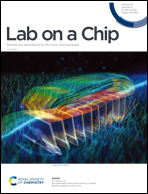Design of highly robust super-liquid-repellent surfaces that can resist high-velocity impact of low-surface-tension liquids†
Abstract
Super-liquid-repellent surfaces capable of preventing wetting with various liquids have tremendous application. However, high liquid repellency relies on surface texturing to minimize the solid–liquid interfacial contact, which generally results in impaired interface robustness and pressure resistance. Consequently, the surface tends to undergo a Cassie–Baxter to Wenzel wetting transition and loses liquid repellency under high-velocity liquid impact, especially for low-surface-tension liquids. Here, surface design through combining the nanoscale effect and doubly reentrant structure is demonstrated to solve the above challenge. By utilizing a facile colloidal lithography process, robust liquid repellent surfaces featuring nanoscale doubly reentrant (NDR) structures are constructed. The nanoscale features ensure sufficient triple contact line density at a low solid–liquid contact fraction to enhance the capillary force for liquid suspension. In conjunction with the doubly reentrant topography that maximizes the upward component of capillary force, such NDR surfaces enable an extremely robust solid–liquid–gas composite interface. As a result, the prepared NDR surface maintain excellent repellency upon high-velocity impact of various liquids, including ethylene glycol drops with a Weber number (We) above 306 and ethanol drops with a We of 57. The above findings can help the development of super-liquid-repellent surfaces applicable to harsh conditions of high-velocity liquid impact or high hydrostatic pressure.



 Please wait while we load your content...
Please wait while we load your content...